1000+ Animal Kingdom Multiple Choice Question Answer [Solved]
Thursday 9th of March 2023

Sharing is caring
1. In phylum echinodermata, the adult echinoderms are ______A__________ but larvae are _______B______ .
A. A radially symmetrical; B bilaterally symmetrical
B. A bilaterally symmetrical; B radially symmetrical
C. A bilaterally symmetrical; B asymmetrical
D. A metamerically segmented; B asymmetrical
Answer : A
A. A radially symmetrical; B bilaterally symmetrical
B. A bilaterally symmetrical; B radially symmetrical
C. A bilaterally symmetrical; B asymmetrical
D. A metamerically segmented; B asymmetrical
Answer : A
2. Which of the following is a chordate feature and not shared by the non-chordates ?
A. Metamerism
B. Axial organization
C. Bilateral symmetry
D. Pharyngeal gill slits
Answer : D
A. Metamerism
B. Axial organization
C. Bilateral symmetry
D. Pharyngeal gill slits
Answer : D
3. Hemichordates have now been placed with the nonchordates, close to echinoderms, because true
A. notochord is absent.
B. pharyngeal gill-slits are lacking.
C. dorsal nerve cord is absent.
D. heart is lacking.
Answer : A
A. notochord is absent.
B. pharyngeal gill-slits are lacking.
C. dorsal nerve cord is absent.
D. heart is lacking.
Answer : A
4. Column-I contains organisms and column-II contains their exeretory structures. Choose the correct match form the options given below.
A. A I; B III; C II; D IV; E V
B. A III; B I; C II; D V; E IV
C. A II; B I; C III; D V; E IV
D. A II; B III; C I; D V; E IV
Answer : D
| Column- I | Column -II |
|---|---|
| (Organism) | (Excretory structures) |
| A. Cockroach | I. Nephridia |
| B. Cat fish | II. Malpighian tubules |
| C. Earthworm | III. Kidneys |
| D. Balanoglossus | IV. Flame cells |
| E. Flatworm | V. Proboscis gland |
A. A I; B III; C II; D IV; E V
B. A III; B I; C II; D V; E IV
C. A II; B I; C III; D V; E IV
D. A II; B III; C I; D V; E IV
Answer : D
5. Which one of the following categories of animals is correctly described with no single exception in it?
A. In chondrichthyes notochord is persistent throughout life.
B. All mammals are viviparous and possess diaphragm for breathing.
C. All sponges are marine.
D. All reptiles possess scales, have a three chambered heart and are cold blooded (poikilothermal).
Answer : A
A. In chondrichthyes notochord is persistent throughout life.
B. All mammals are viviparous and possess diaphragm for breathing.
C. All sponges are marine.
D. All reptiles possess scales, have a three chambered heart and are cold blooded (poikilothermal).
Answer : A
6. Which of the following is an incorrect statement regarding flatworms ?
A. They are acoelomates.
B. They are bilaterally symmetrical.
C. They lack a digestive system.
D. They have a circulatory system.
Answer : D
A. They are acoelomates.
B. They are bilaterally symmetrical.
C. They lack a digestive system.
D. They have a circulatory system.
Answer : D
7. Identify the correct characteristic feature shown by the given figure?

A. Diploblastic in nature.
B. Having radial symmetrical body.
C. Dioecious with direct development.
D. Presence of sensory tentacles on anterior head region.
Answer : D

A. Diploblastic in nature.
B. Having radial symmetrical body.
C. Dioecious with direct development.
D. Presence of sensory tentacles on anterior head region.
Answer : D
8. Which of the following statement(s) is/are correct regarding class aves?
(i) The forelimbs are modified into wings and the hindlimbs generally have scales and are modified for walking, swimming or clasping the tree branches.
(ii) Heart is completely four-chambered.
(iii) They are warm- blooded (homoiothermous) animals i.e., they are able to maintain a constant body temperature.
(iv) They are oviparous and development is direct.
A. Both (i) and (iii)
B. Both (i) and (iv)
C. (i), (ii) and (iii)
D. All of these
Answer : D
(i) The forelimbs are modified into wings and the hindlimbs generally have scales and are modified for walking, swimming or clasping the tree branches.
(ii) Heart is completely four-chambered.
(iii) They are warm- blooded (homoiothermous) animals i.e., they are able to maintain a constant body temperature.
(iv) They are oviparous and development is direct.
A. Both (i) and (iii)
B. Both (i) and (iv)
C. (i), (ii) and (iii)
D. All of these
Answer : D
9. Which of the following statements is incorrect ?
A. Prawn has two pairs of antennae.
B. Nematocysts are characteristic feature of the phylum cnidaria.
C. Millipedes have two pairs of appendages in each segment of the body.
D. Animals that belong to phylum porifera are exclusively marine.
Answer : D
A. Prawn has two pairs of antennae.
B. Nematocysts are characteristic feature of the phylum cnidaria.
C. Millipedes have two pairs of appendages in each segment of the body.
D. Animals that belong to phylum porifera are exclusively marine.
Answer : D
10. The transition from aquatic to terrestrial lifestyles required many adaptations in the vertebrate lineage. Which of the following is not one of those adaptations ?
A. Switch from gill respiration to air-breathing lungs.
B. Improvements in water resistance of skin.
C. Alteration in mode of locomotion.
D. Development of feathers for insulation.
Answer : D
A. Switch from gill respiration to air-breathing lungs.
B. Improvements in water resistance of skin.
C. Alteration in mode of locomotion.
D. Development of feathers for insulation.
Answer : D
11. Identify the figure with its correct name and phylum.
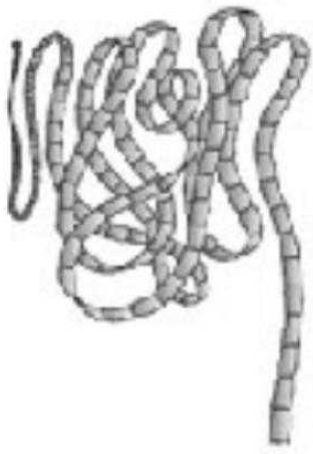
A. Sycon - Porifera
B. Aurelia - Coelenterata
C. Pleurobrachia - Ctenophora
D. Tapeworm - Platyhelminthes
Answer : D

A. Sycon - Porifera
B. Aurelia - Coelenterata
C. Pleurobrachia - Ctenophora
D. Tapeworm - Platyhelminthes
Answer : D
12. Refer the figures A, B and C and choose the correct option which shows animals that regulate buoyancy with the help of air bladder.
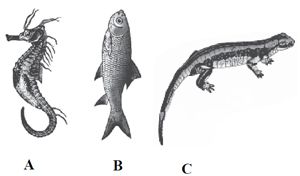
A. A and B
B. A and C
C. B and C
D. All of the above.
Answer : A

A. A and B
B. A and C
C. B and C
D. All of the above.
Answer : A
13. Aquatic annelids (like Nereis) possess lateral appendages called ______________, which help in swimming.
A. visceral hump
B. parapodia
C. radula
D. spicules
Answer : B
A. visceral hump
B. parapodia
C. radula
D. spicules
Answer : B
14. Which of the following is not a characteristic of phylum echinodermata ?
A. They have a water vascular system.
B. They have an internal skeleton.
C. They are protostomes.
D. They have bilateral symmetry at larval stage.
Answer : C
A. They have a water vascular system.
B. They have an internal skeleton.
C. They are protostomes.
D. They have bilateral symmetry at larval stage.
Answer : C
15. The given figures of animals (A & B) are distinguished on the basis of symmetry. Select the correct option which shows the type of symmetry and its description against the animals.
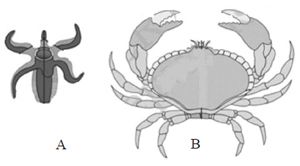
A. A : Biradial, organisms is divided into unequal halves by any plane through the central axis.
B. B: Bilateral, body is divided into equivalent right and left halves by only one plane.
C. A: Asymmetrical, organisms is not divided into equal halves by any plane through the central axis.
D. B: Radial, in which any plane passing through the central axis of the body divides the organism into two identical halves.
Answer : B

A. A : Biradial, organisms is divided into unequal halves by any plane through the central axis.
B. B: Bilateral, body is divided into equivalent right and left halves by only one plane.
C. A: Asymmetrical, organisms is not divided into equal halves by any plane through the central axis.
D. B: Radial, in which any plane passing through the central axis of the body divides the organism into two identical halves.
Answer : B
A. Hairy skin and oviparity
B. Hairy skin and mammary glands
C. Mammary glands and teeth
D. Pinna and teeth
Answer : B
17. Which of the following is a living fossil?
A. Balanoglossus
B. Echinus
C. Ancylostoma
D. Limulus
Answer : D
A. Balanoglossus
B. Echinus
C. Ancylostoma
D. Limulus
Answer : D
18. Which of the following animal's body is covered by calcareous shell and unsegmented with a distinct head, muscular foot, and visceral hump?
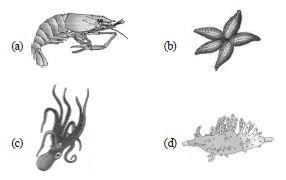
A. Click to check answer
B. Click to check answer
C. Click to check answer
D. Click to check answer
Answer : C

A. Click to check answer
B. Click to check answer
C. Click to check answer
D. Click to check answer
Answer : C
19. Which of the following class is being correctly described by given statements (i - iv)?
(i) All living members of this class are ectoparasites on some fishes.
(ii) They have a sucking and circular mouth without jaws.
(iii) Circulation is of closed type.
(iv) They are marine but migrate for spawning to fresh water. After spawing, within a few days they die.
A. Cyclostomata
B. Chondrichthyes
C. Osteichthyes
D. Amphibia
Answer : A
(i) All living members of this class are ectoparasites on some fishes.
(ii) They have a sucking and circular mouth without jaws.
(iii) Circulation is of closed type.
(iv) They are marine but migrate for spawning to fresh water. After spawing, within a few days they die.
A. Cyclostomata
B. Chondrichthyes
C. Osteichthyes
D. Amphibia
Answer : A
20. Read the following statements and answer the question.
(i) They are exclusively marine, radially symmetrical, diploblastic organisms with tissue level of organisation.
(ii) Body bears eight external rows of ciliated comb plates, which help in locomotion.
(iii) Digestion is both extracellular and intracellular.
(iv) Reproduction takes place only by sexual means.
Which of the following phylum is being described by above statements?
A. Platyhelminthes
B. Arthropoda
C. Mollusca
D. Ctenophora
Answer : D
(i) They are exclusively marine, radially symmetrical, diploblastic organisms with tissue level of organisation.
(ii) Body bears eight external rows of ciliated comb plates, which help in locomotion.
(iii) Digestion is both extracellular and intracellular.
(iv) Reproduction takes place only by sexual means.
Which of the following phylum is being described by above statements?
A. Platyhelminthes
B. Arthropoda
C. Mollusca
D. Ctenophora
Answer : D
21. Which of the following is a correct match of a phylum with their three examples?
A. PlatyhelminthesPlanaria, Schistosoma, Enterobius
B. Mollusca Loligo, Sepia, Octopus
C. Porifera Spongilla, Euplectella, Pennatula
D. Cnidaria Bonellia, Physalia, Aurelia
Answer : B
A. PlatyhelminthesPlanaria, Schistosoma, Enterobius
B. Mollusca Loligo, Sepia, Octopus
C. Porifera Spongilla, Euplectella, Pennatula
D. Cnidaria Bonellia, Physalia, Aurelia
Answer : B
22. __________ is responsible for maintaining the current of water in sponge.
A. Osculum
B. Porocytes
C. Spongocoel
D. Choanocytes
Answer : D
A. Osculum
B. Porocytes
C. Spongocoel
D. Choanocytes
Answer : D
23. Which of the following animals are bilaterally symmetrical?

A. 1 & 2
B. 2 & 4
C. 3 & 4
D. 1 & 3
Answer : B

A. 1 & 2
B. 2 & 4
C. 3 & 4
D. 1 & 3
Answer : B
24. Match the phylum given in column - I with their example given in column - II and choose the correct option.
A. A IV; B II; C I; D III
B. A II; B IV; C I; D III
C. A II; B IV; C III; D I
D. A II; B I; C IV; D III
Answer : B
| Column -I | Column- II |
|---|---|
| (Phylum) | (Examples) |
| A. Echinodermata | I. Ascidia, Doliolum |
| B. Hemichordata | II. Asterias, Ophiura |
| C. Urochordata | III. Branchiostoma |
| D. Cephalochordata | IV. Balanoglossus, Saccoglossus |
A. A IV; B II; C I; D III
B. A II; B IV; C I; D III
C. A II; B IV; C III; D I
D. A II; B I; C IV; D III
Answer : B
25. Which of the following sets of animals give birth to young ones?
A. Platypus, Penguin, Bat, Hippopotamus.
B. Shrew, Bat, Cat, Kiwi.
C. Kangaroo, Hedgehog, Dolphin, Loris.
D. Lion, Bat, Whale, Ostrich.
Answer : C
A. Platypus, Penguin, Bat, Hippopotamus.
B. Shrew, Bat, Cat, Kiwi.
C. Kangaroo, Hedgehog, Dolphin, Loris.
D. Lion, Bat, Whale, Ostrich.
Answer : C
26. Identify the correct characteristics of porifera.
A. (ii), (v) only
B. (i), (ii), (vi) only
C. (i), (ii), (iii), (iv) only
D. All of these.
Answer : A
- Commonly known as sea walnuts.
- Presence of ostia and collar cells.
- Exhibit tissue level of characteristics.
- It is the largest phylum of animal kingdom.
- The body is supported by spicules and sponging fibers.
- Contains cnidocytes which is used for defense, anchorage and capturing of prey.
A. (ii), (v) only
B. (i), (ii), (vi) only
C. (i), (ii), (iii), (iv) only
D. All of these.
Answer : A
27. Heart is three - chambered in reptiles, except
A. turtle
B. Chameleon
C. Naja (Cobra)
D. crocodile
Answer : D
A. turtle
B. Chameleon
C. Naja (Cobra)
D. crocodile
Answer : D
28. The organisms attached to the substratum generally possess
A. one single opening to the digestive canal.
B. cilia on the surface to create water current.
C. radial symmetry.
D. asymmetrical body.
Answer : C
A. one single opening to the digestive canal.
B. cilia on the surface to create water current.
C. radial symmetry.
D. asymmetrical body.
Answer : C
29. Which of the follwoing statement(s) is/are correct?
(i) Organ systems in different group of animals show various patterns of complexities.
(ii) The digestive system in platyhelminthes has only a single opening to the outside of the body that serve as both mouth and anus, and is hence called complete.
(iii) In open type of circulatory system, the blood is pumped out of the heart and the cells and tissues are directly bathed in it.
(iv) In closed type, the blood is circulated through a series of vessels of varying diameters (arteries, veins and capillaries).
A. Only (i)
B. Both (ii) and (iii)
C. (i), (iii) and (iv)
D. All of these
Answer : C
(i) Organ systems in different group of animals show various patterns of complexities.
(ii) The digestive system in platyhelminthes has only a single opening to the outside of the body that serve as both mouth and anus, and is hence called complete.
(iii) In open type of circulatory system, the blood is pumped out of the heart and the cells and tissues are directly bathed in it.
(iv) In closed type, the blood is circulated through a series of vessels of varying diameters (arteries, veins and capillaries).
A. Only (i)
B. Both (ii) and (iii)
C. (i), (iii) and (iv)
D. All of these
Answer : C
30. Which of the following statement(s) is/are correct?
(i) Animals in which the cells are arranged in two embryonic layers, an external ectoderm and an internal endoderm, are called diploblastic animals.
(ii) Notochord is an ectodermally derived rod like structure formed on the ventral side during embryonic development in some animals.
(iii) In some animals, the body cavity is not lined by mesoderm, instead, the mesoderm is present as scattered pouches in between the ectoderm and endoderm and such a body cavity is called pseudocoelom.
A. Only (i)
B. Both (i) and (ii)
C. Both (i) and (iii)
D. All of these
Answer : C
(i) Animals in which the cells are arranged in two embryonic layers, an external ectoderm and an internal endoderm, are called diploblastic animals.
(ii) Notochord is an ectodermally derived rod like structure formed on the ventral side during embryonic development in some animals.
(iii) In some animals, the body cavity is not lined by mesoderm, instead, the mesoderm is present as scattered pouches in between the ectoderm and endoderm and such a body cavity is called pseudocoelom.
A. Only (i)
B. Both (i) and (ii)
C. Both (i) and (iii)
D. All of these
Answer : C
31. Which of the following statement is incorrect?
A. Platyhelminthes has incomplete digesive system.
B. In coelenterates, the arrangement of cells is more complex.
C. Nereis is monoecious but earthworms and leeches are dioecious.
D. Simple and compound eyes are present in the animals of those phylum whose over two-thirds of all named species on earth are arthropods.
Answer : C
A. Platyhelminthes has incomplete digesive system.
B. In coelenterates, the arrangement of cells is more complex.
C. Nereis is monoecious but earthworms and leeches are dioecious.
D. Simple and compound eyes are present in the animals of those phylum whose over two-thirds of all named species on earth are arthropods.
Answer : C
32. Which of the following is not a chordate character?
A. Presence of paired pharyngeal gill slits
B. Ventral heart
C. Solid and ventral nerve cord
D. Presence of post-anal tail
Answer : C
A. Presence of paired pharyngeal gill slits
B. Ventral heart
C. Solid and ventral nerve cord
D. Presence of post-anal tail
Answer : C
33. Tracheae of cockroach and mammal are similar in having
A. paired nature.
B. non-collapsible walls.
C. ciliated inner lining.
D. origin from head.
Answer : B
A. paired nature.
B. non-collapsible walls.
C. ciliated inner lining.
D. origin from head.
Answer : B
34. Which of the following is a connecting link between invertebrates and non-invertebrates?
A. Sphenodon
B. Balanoglossus
C. Tadpole larva
D. Crocodile
Answer : B
A. Sphenodon
B. Balanoglossus
C. Tadpole larva
D. Crocodile
Answer : B
35. Which of the following characteristic distinguish arthropoda from annelids and molluscs ?
A. An external skeleton made of chitin (a polysaccharide) and protein rather than a shell made chiefly of mineral salts.
B. Subdivision of the legs into movable segments.
C. Distinct group of muscles, derived from many body segments, that move the separate parts of the exoskeleton.
D. All of the above
Answer : D
A. An external skeleton made of chitin (a polysaccharide) and protein rather than a shell made chiefly of mineral salts.
B. Subdivision of the legs into movable segments.
C. Distinct group of muscles, derived from many body segments, that move the separate parts of the exoskeleton.
D. All of the above
Answer : D
36. Refer the following statement and answer the question. 'Name of X is derived from stinging capsules. It exhibits metagenesis containing two body forms in which sessile and cylindrical form is called Y and umbrella shaped and free swimming is called Z. Identify X, Y, and Z.
A. X - Coelenterate, Y - Polyp, Z - Medusa
B. X - Cnidarian, Y - Medusa, Z - Polyp
C. X - Ctenophora, Y - Radula, Z - Hypostome
D. X - Porifera, Y - Osculum, Z - Radula
Answer : A
A. X - Coelenterate, Y - Polyp, Z - Medusa
B. X - Cnidarian, Y - Medusa, Z - Polyp
C. X - Ctenophora, Y - Radula, Z - Hypostome
D. X - Porifera, Y - Osculum, Z - Radula
Answer : A
37. Which of the following phylum is being described by the given statements?
(i) They are bilaterally symmetrical,triploblastic, segmented and coelomate animals.
(ii) The body consists of head, thorax, abdomen and have jointed appendages.
(iii) Circulatory system is of open type.
(iv) Excretion takes place through malphigian tubules.
A. Arthropoda
B. Annelida
C. Mollusca
D. Echinodermata
Answer : A
(i) They are bilaterally symmetrical,triploblastic, segmented and coelomate animals.
(ii) The body consists of head, thorax, abdomen and have jointed appendages.
(iii) Circulatory system is of open type.
(iv) Excretion takes place through malphigian tubules.
A. Arthropoda
B. Annelida
C. Mollusca
D. Echinodermata
Answer : A
38. Column I contains zoological names of animals and column II contains their common name. Match the following and choose the correct option.
A. A III; B II; C I; D IV
B. A IV; B III; C II; D I
C. A IV; B II; C III; D I
D. A II; B III; C I; D IV
Answer : C
| Column -I | Column- II |
|---|---|
| A. Physalia | I. Sea anemone |
| B. Meandrina | II. Brain coral |
| C. Gorgonia | III. Sea fan |
| D. Adamsia | IV. Portuguese man-of-war |
A. A III; B II; C I; D IV
B. A IV; B III; C II; D I
C. A IV; B II; C III; D I
D. A II; B III; C I; D IV
Answer : C
39. Identify the animals shown in the given figures A, B and C from options given below.

A. A - Octopus; B -Asterias, C- Ophiura
B. A - Asterias; B - Ophiura, C- Octopus
C. A - Echinus; B - Octopus C - Ophiura
D. A - Ophiura; B - Echinus, C- Octopus
Answer : A

A. A - Octopus; B -Asterias, C- Ophiura
B. A - Asterias; B - Ophiura, C- Octopus
C. A - Echinus; B - Octopus C - Ophiura
D. A - Ophiura; B - Echinus, C- Octopus
Answer : A
40. A file like rasping organ for feeding, called radula, present in the phylum __________.
A. arthropoda
B. mollusca
C. echinodermata
D. chordata
Answer : B
A. arthropoda
B. mollusca
C. echinodermata
D. chordata
Answer : B
41. Which of the following characteristic is probably most responsible for the great diversification of insects on land ?
A. Segmentation
B. Antennae
C. Bilateral symmetry
D. Exoskeleton
Answer : D
A. Segmentation
B. Antennae
C. Bilateral symmetry
D. Exoskeleton
Answer : D
42. Which of the following statement(s) is/are correct for class amphibia?
(i) Body is divisible into head and trunk.
(ii) Respiration is through gills only.
(iii) The heart is two chambered i.e. one auricle and one ventricle.
(iv) Fertilization is internal.
A. Only (i)
B. Only (iv)
C. (i), (ii) and (iii)
D. All of these
Answer : A
(i) Body is divisible into head and trunk.
(ii) Respiration is through gills only.
(iii) The heart is two chambered i.e. one auricle and one ventricle.
(iv) Fertilization is internal.
A. Only (i)
B. Only (iv)
C. (i), (ii) and (iii)
D. All of these
Answer : A
43. Which of the following is not the common fundamental feature for animal classification?
A. Germinal layers.
B. Pathway of water transport.
C. Pattern of organization of cells.
D. Serial repetition of the segments.
Answer : B
A. Germinal layers.
B. Pathway of water transport.
C. Pattern of organization of cells.
D. Serial repetition of the segments.
Answer : B
44. In phylum arthropoda, excretion takes place through
A. nephridia
B. flame cells
C. malphigian tubules
D. gills
Answer : C
A. nephridia
B. flame cells
C. malphigian tubules
D. gills
Answer : C
45. Examine the figures A, B and C. In which one of the four options all the items A, B and C are correctly identified ?

A. A - Sycon, B - Euspongia, C - Spongilla
B. A - Euspongia, B - Spongilla, C - Sycon
C. A - Spongilla, B - Sycon, C - Euspongia
D. A - Euspongia, B - Sycon, C - Spongilla
Answer : A

A. A - Sycon, B - Euspongia, C - Spongilla
B. A - Euspongia, B - Spongilla, C - Sycon
C. A - Spongilla, B - Sycon, C - Euspongia
D. A - Euspongia, B - Sycon, C - Spongilla
Answer : A
46. The figure given below shows the germinal layers marked as A, B, C and D. Identify the label showing undifferentiated layer and its location?
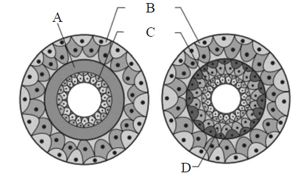
A. A, Between B & C
B. B, Between A & C
C. C, Between C & D
D. D, Between A & B
Answer : A

A. A, Between B & C
B. B, Between A & C
C. C, Between C & D
D. D, Between A & B
Answer : A
47. Match the phylum given in column - I with the special features present in them given in column - II and choose the correct option.
A. A III; B IV; C V; D II; E I
B. A IV; B III; C V; D II; E I
C. A III; B IV; C II; D V; E I
D. A III; B V; C IV; D II; E I
Answer : A
| Column -I | Column- II |
|---|---|
| (Phylum) | (Special features present) |
| A. Porifera | I. Mammary glands |
| B. Mollusca | II. Cloaca |
| C. Ctenophora | III. Choanocytes |
| D. Amphibia | IV. Radula |
| E. Mammalia | . Comb plates |
A. A III; B IV; C V; D II; E I
B. A IV; B III; C V; D II; E I
C. A III; B IV; C II; D V; E I
D. A III; B V; C IV; D II; E I
Answer : A
48. The given figures (A & B) shows the germinal layer. The animals having structures shown in the figures are respectively called

A. diploblastic, triploblastic
B. triploblastic, diploblastic
C. diploblastic, diploblastic
D. triploblastic, triploblastic
Answer : A

A. diploblastic, triploblastic
B. triploblastic, diploblastic
C. diploblastic, diploblastic
D. triploblastic, triploblastic
Answer : A
49. A student brought home a strange animal which he found outside under a rock. It had moist skin, a complete digestive tract, a ventral nerve cord, and had gone through torsion. Identify the phylum of the animal.
A. Porifera
B. Annelida
C. Mollusca
D. Echinodermata
Answer : B
A. Porifera
B. Annelida
C. Mollusca
D. Echinodermata
Answer : B
50. Which of the following is not a characteristic feature of kingdom animalia ?
A. Storage of carbohydrates as starch.
B. Multicellularity.
C. Obtaining nutrients by ingestion.
D. Having eukaryotic cells without walls.
Answer : A
A. Storage of carbohydrates as starch.
B. Multicellularity.
C. Obtaining nutrients by ingestion.
D. Having eukaryotic cells without walls.
Answer : A
Sharing is caring
Related Post
JavaScript MCQ Solved Paper for RRB JE
Chemical Engineering Plant Economics 1000+ MCQ with answer for SSC Scientific Assistant
IBPS SO - Manufacturing & Production Engineering 1000+ MCQ [Solved] PDF Download
RRB Group D - Planet Kingdom 1000+ MCQ [Solved] PDF Download
1000+ Human reproductive system Multiple Choice Question Answer [Solved]
1000+ DBMS Multiple Choice Question Answer [Solved]